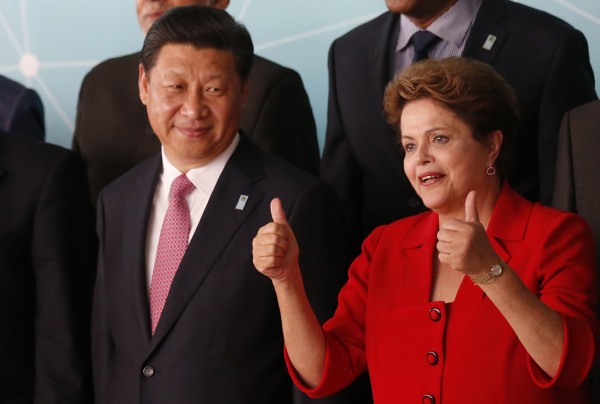China-Latin America Fast Track Relations After Xi Signs Rail Agreement
| Gunnar Blaschke | | Jul 18, 2014 07:17 AM EDT |
(Photo : REUTERS/Sergio Moraes) China's President Xi Jinping (L) and Brazil's President Dilma Rousseff after the meeting of China and CELAC at Itamaraty Palace in Brasilia July 17, 2014.
Chinese President Xi Jinping signed an agreement with Brazil during a meeting with the Community of Latin American and Caribbean States on Thursday to start laying the tracks for a 1.630-kilometer long railway in the central part of Brazil.
The agreement will further strengthen the relations between the two countries and the two regions.
Like Us on Facebook
Furthermore, Xi proposed to establish a Peru-Brazil transcontinental railway that would significant improve infrastructure, contribute to regional integration and give the economies a boost for their exports.
However, Chinese investments are more than a question of fresh cash to Latin America. China is about to open up to the continent's interior, which for long has been a goal for Brazil and other countries in the region.
Brazil officials welcome Chinese rail companies to get more involved in improving the nation's infrastructure, thus, improving possibilities for Brazil to remain among the fastest growing economies in the world.
One of the more direct achievements from the railway agreement in central Brazil will be to secure the transportation of soybean from the middle-western part of the country.
According to Xi's proposal of establishing a transcontinental railway from Peru on the Pacific coast to Brazil on the Atlantic coast, there will be a trilateral working group that will suggests railway plans, designs, construction and operation.
Latin America is one of the world's leading suppliers of raw materials such as ore, grain and meat. Improvement of the infrastructure by improving the rail network would mean everything and boost the possibilities for export further.
An agreement on a railway that crosses two countries, from Peru to Brazil, would reduce the cost of export to china and also cut the delivery time since shipping could be done from the Pacific coast instead of from the Atlantic coast as the case is today.
TagsCELAC
©2015 Chinatopix All rights reserved. Do not reproduce without permission
EDITOR'S PICKS
-

Did the Trump administration just announce plans for a trade war with ‘hostile’ China and Russia?
-

US Senate passes Taiwan travel bill slammed by China
-

As Yan Sihong’s family grieves, here are other Chinese students who went missing abroad. Some have never been found
-

Beijing blasts Western critics who ‘smear China’ with the term sharp power
-

China Envoy Seeks to Defuse Tensions With U.S. as a Trade War Brews
-

Singapore's Deputy PM Provides Bitcoin Vote of Confidence Amid China's Blanket Bans
-

China warns investors over risks in overseas virtual currency trading
-

Chinese government most trustworthy: survey
-

Kashima Antlers On Course For Back-To-Back Titles
MOST POPULAR
LATEST NEWS
Zhou Yongkang: China's Former Security Chief Sentenced to Life in Prison

China's former Chief of the Ministry of Public Security, Zhou Yongkang, has been given a life sentence after he was found guilty of abusing his office, bribery and deliberately ... Full Article
TRENDING STORY

China Pork Prices Expected to Stabilize As The Supplies Recover

Elephone P9000 Smartphone is now on Sale on Amazon India

There's a Big Chance Cliffhangers Won't Still Be Resolved When Grey's Anatomy Season 13 Returns

Supreme Court Ruled on Samsung vs Apple Dispute for Patent Infringement

Microsoft Surface Pro 5 Rumors and Release Date: What is the Latest?










